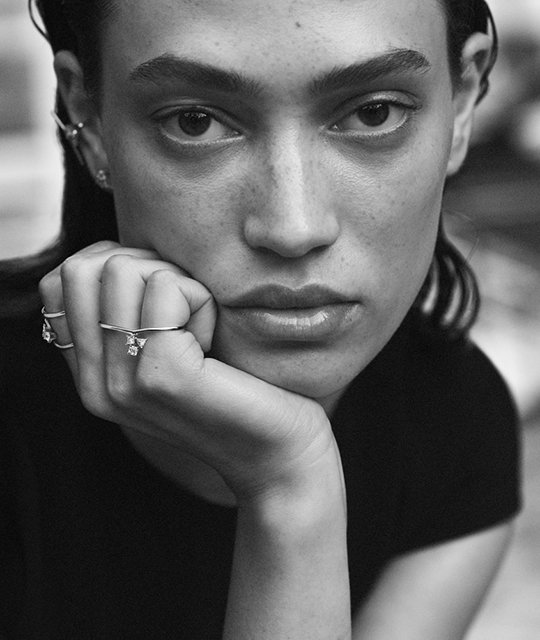ACCESSIBLE LUXURY – A NATURAL HOME FOR LAB-GROWN DIAMONDS
An image from a recent campaign by SUM for ÂME - a luxury lab grown diamond brand
In the diamond jewellery category lies a conundrum.
While Bloomberg report that ‘prices are in free fall in one corner of the market’, this is not yet being seen across the whole industry.
The corner in question is focused on the more affordable one- or two-carat solitaire bridal rings, which are experiencing soaring demand among price-sensitive consumers.
Post-pandemic, they have been able to ‘splash out on travel and experiences’ as well as being able to buy a real diamond at a much cheaper price.
The stone is ‘real’ because, as a recent piece in Vogue reminded us, ‘Lab diamonds are chemically identical to natural diamonds’.
This raises the question as to why lab-grown has not yet gained significant share in the fine and high jewellery sectors?
To summarise: If all lab-grown diamonds are real-yet-cheaper, then why are they more popular in some parts of the jewellery market than in others?
It is certainly not for want of trying. Brands such as Dorsey, Courbet, Mazarin, Cris Porto, and Vrai (in which Leonardo DiCaprio is an investor), are all including some premium-priced lab-grown pieces in their respective collections. In addition, there have been countless Hollywood celebrity red-carpet appearances where lab-grown diamonds have been worn.
At SUM we believe that the reason for the discrepancy is that the consumer dynamics at the top of the market are so different from those at its lower levels.
A person wearing a $45,000 necklace made with mined diamonds is likely to be aware that if the stones had been lab-grown they would effectively be the same as the mined ones she had bought, and would have some ecological benefits to boot. But she will also consider aspects such as authenticity, the designer’s reputation, craftsmanship, and an expectation of a high potential re-sale value if the piece was to need to be sold in a few years’ time. And for her, these factors appear to be continuing to outweigh the potential benefits of lab-grown. Indeed, she is likely to attribute considerably more authenticity to her mined diamonds than she is to lab-grown alternatives.
Many would claim that this is essentially about perception rather than about reality – that the 4C’s of Color, Clarity, Cut, and Carat weight are all essentially the same across mined and lab-grown. But equally, consumer perception cannot be dismissed because the entire diamond industry has arguably been built on favourable perception to maintain both its appeal and its price points.
Such insights are likely to be behind the decisions of heritage brands such as Tiffany, Bulgari, and Chaumet to resist the inclusion of any lab-grown stones in their jewellery.
The consumer mindset at the top of the market is in dramatic contrast to that at the more affordable end, where the aesthetics of the diamond, together with its sale price are key. A certification by the GIA, as well as an awareness of sustainable credentials are further persuasive benefits that have been pushing price-conscious consumers towards buying lab-grown.
Having looked at the two polarities of the market, it seems clear where the next growth phase for lab-grown diamond jewellery will come from, and that is from brands offering accessible luxury.
By accessible luxury, we are referring to brands that are creating luxury items that are consistently sold at somewhat more affordable prices. To draw a parallel, in the fashion space one might consider the likes of Michael Kors, Coach, and Tory Burch - as opposed to premium luxury names such as Gucci, Dior, and Chanel.
Successful accessible luxury brands tend to convey very similar visual branding cues as premium luxury names, yet the consumer knows that when they pull out their credit card, the pricing level will be somewhat more affordable.
In this light it is unsurprising that in the jewellery space the likes of Pandora and Swarovski have in recent years been embracing lab-grown diamonds to a great extent.
Within two or three years we will no doubt have been able to identify a threshold as to how high up the positioning pyramid a jewellery brand can successfully compete when working with lab-grown diamonds. While the decision will no doubt be the subject of considerable ongoing discussion within the industry, it is primarily going to be decided by the consumer.
If you would like to discuss your own jewellery brand with SUM, please feel free to reach out.
Looking to take your brand further?
Explore our specialist services for luxury brands:



